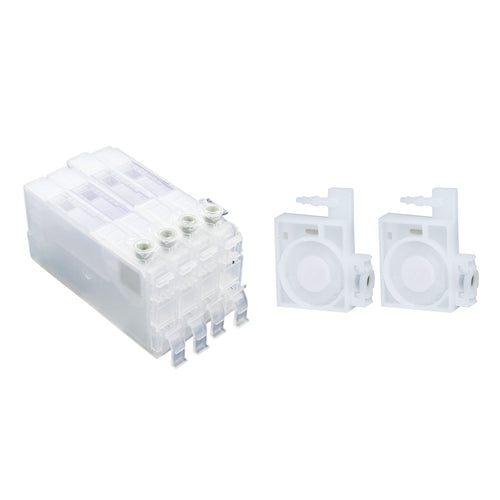As we begin 2025, it's the perfect time to plan for the year ahead. The customized gift industry is undoubtedly the mainstream of 2025. Let Inkbear the Bear show you two popular printing methods: sublimation and DTF. Inkbear will explain the differences and suggest great suppliers. It will help you set up a reliable production line for your custom business. And it also ensures smooth marketing and promotion.
1. What are sublimation printing and DTF printing
Sublimation Printing: Sublimation means gasification. A sublimation printer prints ink on sublimation transfer paper. Then, a heat press heats the sublimation ink to 180°C to 220°C. This process makes the ink turn into gas. The gas seeps into polyester fibers or coated materials. So the item is finished.
DTF (Direct to Film) Printing is a technology that directly prints onto a DTF transfer film. DTF printing uses hot-melt powder, usually made from TPU. When heated, it creates a sticky layer. This layer helps the printed design stick to the fabric well. So the design won’t easily fade or peel.
2. Comparison of Consumables in Sublimation Printing vs. DTF Printing
Both sublimation and DTF printing involve the use of ink and transfer media, but the characteristics of these consumables greatly influence the printing results. Here, Inkbear will explain the secrets behind them.
2.1. Ink Differences:

Sublimation Printing The printer uses dye inks. Dye ink particles are smaller than those of pigment ink, measuring less than a nanometer (one-billionth of a meter), making them easily soluble in water. And the color system typically includes only four colors (CMYK). It has some major features:
Sublimation printing generally looks lighter compared to DTF printing. Because DTF pigment will reflect more light, and DTF printing will do a white layer as a basic layer(white color will reflect all colors).
Sublimation ink particles are small, so when they turn into gas. It easily seeps into polyester fibers or specially coated materials. At the same time, the sublimation printing is easily lighter after washing.
DTF Printing uses pigment inks. And DTF printing uses the color system, which includes five colors (CMYKW). Therefore, it has several major features:
DTF ink is pigment-based, so it reflects more colors and then looks colorful.
DTF printing often does a white layer. It makes the DTF printing more vivid and eye-catching.
2.2. Transfer Medium Differences:
Transfer Medium includes two parts: transfer media and target materials.


Sublimation printing requires sublimation transfer paper. The design is printed on paper. Then, it’s transferred to the material with high heat and pressure. The target material must be polyester or have a special coating to absorb the ink.
DTF printing prints directly on DTF transfer film. Next, hot-melt powder is sprinkled onto the transfer film, which is then dried. Once dry, the film is ready to use, and the design can be transferred to fabric using a heat press.
2.3. Conclusion
DTF needs a bigger initial investment. But it can create a wider range of high-quality custom products. Sublimation technology uses fewer consumables. However, the final product lacks the rich experience and texture that DTF printers offer.
3. Comparison of Printing Speed
Sublimation printing is relatively fast. In both the printing and transfer stages, it usually takes 30 seconds to 1 minute. This speed makes it great for mass production, especially in quick production settings.
DTF printing moves at a slower pace compared to sublimation printing. This is because it provides more precision and color, and takes longer.
4. The Difference of Printing Workflows
4.1. Sublimation Printing Steps:
Design: Use design tools like Adobe Illustrator or CorelDRAW to make the design.
Printing: Using a sublimation printer to print the design onto sublimation transfer paper.
Transfer Prep: First, align the sublimation transfer paper with your produce items. Such as polyester or coated fabric. Then, place it in a heat press.
Heat Press: Apply heat and pressure (like 180°C to 220°C) to transfer the design from the paper to the fabric.
Completion: Remove the transferred material.
4.2. DTF Printing Steps:
Design: Create and adjust the design using design software, ensuring it is suitable for printing and transfer. And many great manufacturers, like InkSonic, offer design software tutorial videos and online help.
Printing: Print the design onto the surface of transfer film using DTF ink.
Powdering: The machine adds hot-melt powder to the ink after printing. This creates a stable layer.
Drying: Use an oven to dry the transfer film, allowing the DTF ink and DTF powder to combine and stabilize.
Transfer: Line up the printed transfer film with the target material. Then, put it in a heat press. The hot-melt powder melts under heat, transferring the design.
Completion: Take away the transferred material. Let it cool. Then, move on to post-processing tasks like cutting and packaging. But some transfer films don't need to wait for it to cool, like hot transfer film.
5. Comparison of Printing Quality
5.1. Touch Feeling:
Sublimation Printing: The design integrates almost seamlessly with the fabric. The ink turns into gas and seeps into the fibers. This creates a smooth and soft finish, especially on clothes or fabrics. You almost don’t feel the design at all.
DTF Printing: The printed design feels raised or textured. It creates a pseudo-3D effect on the fabric.
5.2. Color Vibrancy:
- Sublimation Printing: The colors are lighter, and the vibrancy depends on the fabric's reflectivity, so it is best suited for use on light-colored or white-coated surfaces.
- DTF Printing: DTF offers vibrant colors because it uses pigment inks and prints a white base layer. It can also be used on dark backgrounds.
5.3. Durability:
- Sublimation Printing: The design is durable, especially on polyester and coated surfaces. The ink bonds tightly with the fibers, making the print resistant to fading, peeling, or damage.
- DTF Printing: This design lasts long, but it depends on the adhesive layer. So, pick high-quality hot-melt powder and learn to use the heat press correctly. If not, the printed design might fade faster, especially with frequent washing or rough fabrics.
6. Comparison of the application range of sublimation printing and DTF printing
Sublimation Printing: This technique is ideal for polyester and specially coated materials. Sublimation printing is lightweight. This quality makes it perfect for sportswear and large prints, like promotional banners.
DTF Printing: This printing method is suitable for various fabrics, including cotton, denim, and leather. It creates vibrant, rich colors. You can make multi-colored T-shirts, hats, bags, and stylish gradient T-shirts with it.
7. A quick comparison table of Sublimation Printing and DTF Printing
Category |
Dye Sublimation Printing |
Direct to Film (DTF) Printing |
Technology Principle |
Ink is heated to gasify and penetrate polyester fibers or coated materials. |
Thermoplastic polyurethane (TPU) powder forms an adhesive layer when heated, bonding designs to fabric surfaces. |
Compatible Materials |
Polyester fibers, coated materials (best for light/white backgrounds). |
All materials (cotton, polyester, denim, leather, blends, etc.), both light and dark fabrics. |
Color System |
CMYK 4-color (no white ink). |
CMYKW 5-color (includes white ink). |
Additional Consumables |
Sublimation transfer paper, specialized ink. |
transfer film, thermoplastic powder, white ink, DTF ink. |
Production Speed |
Fast: Printing + transfer (~30 sec–1 min), ideal for bulk orders. |
Moderate: Suitable for small/medium batches or complex designs. |
Workflow |
Design → Print transfer paper → Heat press → Finish. |
Design → Print transfer film → Apply powder → Dry → Heat press → Finish. |
Texture of Design |
Soft and seamless, fully integrated with fabric. |
Slightly textured (some may find it less comfortable). |
Color Performance |
Vibrant on light fabrics; dark fabrics require pre-treatment. |
Works on any fabric color, with rich and vivid patterns. |
Durability |
High durability: Fade-resistant, long-lasting (especially on polyester). |
Good: Resistant to washing but may fade slightly with frequent abrasion. |
Advantages |
- Lower cost - Faster production - Lightweight finish (ideal for sportswear, flags, mugs). |
- Compatible with all fabrics - No pre-treatment for dark fabrics - Excellent for detailed designs. |
Disadvantages |
- Limited to polyester/coated materials - Requires pre-treatment for dark fabrics. |
- Higher material costs - Textured feel may discomfort some users. |
8. Conclusion
This article explains the differences between sublimation printing and DTF printing. It looks at four key areas:
- Printing consumables
Finished product quality
Printing speed
Application range
If you want high-quality customization, DTF printing is the way to go. But if you need mass production and quick turnaround, sublimation printing is better.

































